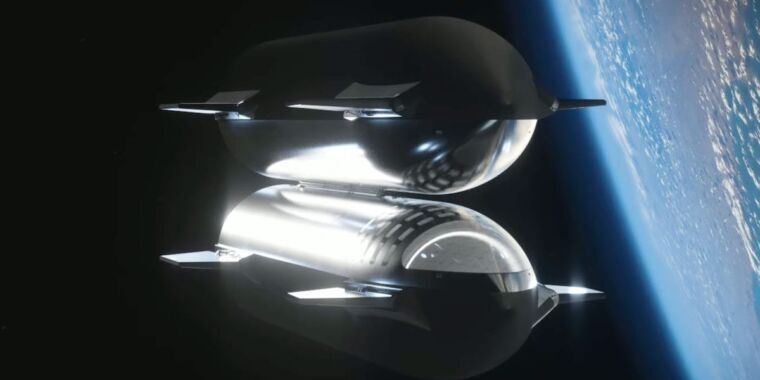“When a mummy & daddy love each other very much…”
This is the best summary I could come up with:
Some time next year, NASA believes SpaceX will be ready to link two Starships in orbit for an ambitious refueling demonstration, a technical feat that will put the Moon within reach.
SpaceX is under contract with NASA to supply two human-rated Starships for the first two astronaut landings on the Moon through the agency’s Artemis program, which aims to return people to the lunar surface for the first time since 1972.
This means they can eventually be reused for multiple missions, and ultimately, could take advantage of propellants produced from resources on the Moon or Mars.
Kshatriya said that while engineers are still analyzing the results of the cryogenic transfer demonstration, the test on the March Starship flight “was successful by all accounts.”
Achieving an in-orbit engine restart—necessary to guide Starship toward a controlled reentry—is a prerequisite for future launches into a stable higher orbit, where the ship could loiter for hours, days, or weeks to deploy satellites and attempt refueling.
To achieve that goal, SpaceX plans to recover and rapidly reuse Starships and Super Heavy boosters, building on expertise from the partially reusable Falcon 9 rocket.
The original article contains 667 words, the summary contains 186 words. Saved 72%. I’m a bot and I’m open source!
The fundamental flow mechanism is because of the pressure delta across the umbilical," Kshatriya said.
So, they don’t plan on using a pump, just thrust and inertia? I don’t get this at all? And won’t that leave a lot of the fuel in the tanker, especially on later launches?
And won’t that leave a lot of the fuel in the tanker, especially on later launches?
Not exactly sure what you mean here? Wouldn’t the amount of propellant left in the tanker depend mostly on the location of the “drain” between tanks? I’m also not clear why the problem would compound with multiple launches. Would you be able to clarify?
If a “natural” pressure differential is the only thing that’s transferring fuel, you can only ever average out the amount of fuel/pressure in both tanks. So if your craft is at 30%, and your tanker at 50%, a natural delta will result in both craft ending up with 40%.
I guess they want to settle the liquid fuel with ullage thrust, and then vent the gas in the craft, but not in the tanker, letting more flow into the craft? The article is very light on details.
Oh, yeah, I’m assuming they have to vent the ullage gas in the receiving tanker. Depending on the layout of the thrusters, they might even be able to utilize this gas to produce the some of the thrust during the propellant transfer.
Shouldn’t spacex be telling us this?
Would you believe them if they did?
Yes, but I would also believe it would change 4 times in the next year
Next year? Isn’t that when all of Tesla’s new stuff is coming out too?
No. But why is NASA running interference for spacex?
Acronyms, initialisms, abbreviations, contractions, and other phrases which expand to something larger, that I’ve seen in this thread:
Jargon Definition cryogenic Very low temperature fluid; materials that would be gaseous at room temperature/pressure ~ (In re: rocket fuel) Often synonymous with hydrolox hydrolox Portmanteau: liquid hydrogen fuel, liquid oxygen oxidizer ullage motor Small rocket motor that fires to push propellant to the bottom of the tank, when in zero-g
[Thread #42 for this sub, first seen 2nd May 2024, 04:50] [FAQ] [Full list] [Contact] [Source code]


